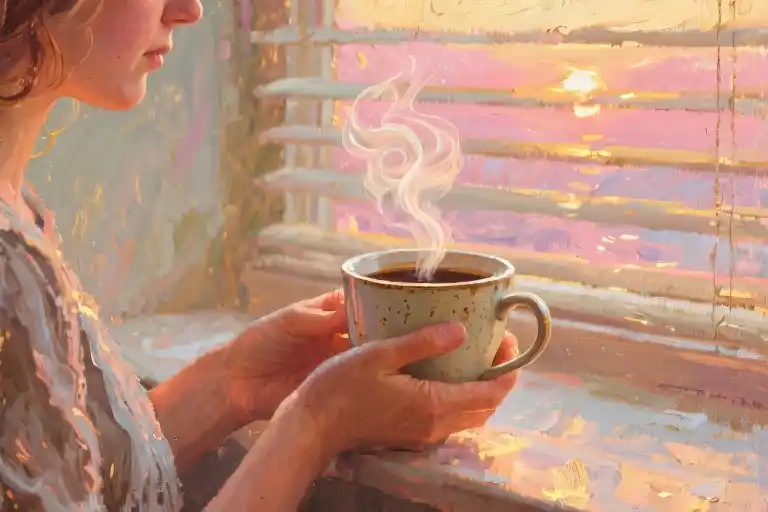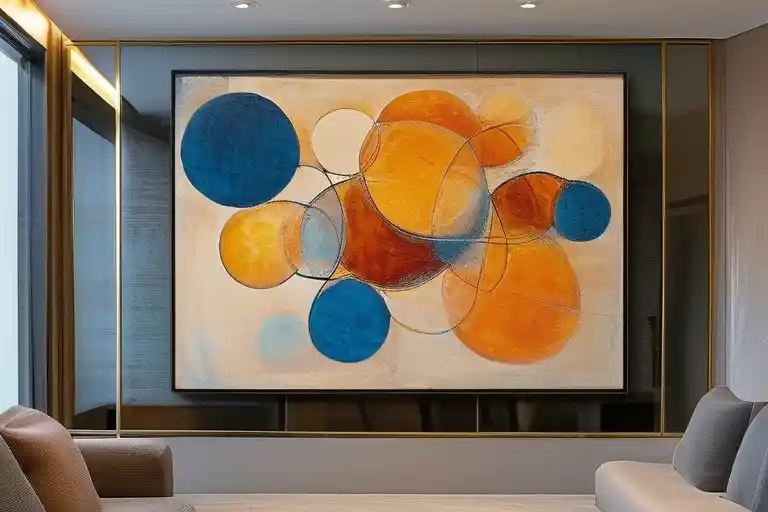The sky was that particular shade of pink—the kind that only appears at 5:48 p.m. in early autumn. I noticed it while waiting for the crosswalk signal, my breath catching slightly as the color reflected off office building windows. In that moment, something shifted. Not dramatically, but with the quiet certainty of a door clicking open. I became aware of my own breathing—the rise and fall of my chest, the way the crisp air felt moving through my nostrils. How long had it been since I’d truly felt myself existing?
You know that feeling, don’t you? When you’re moving through your days completing tasks, having conversations, even laughing at appropriate moments—yet somewhere along the way, you’ve become a spectator in your own life. The coffee tastes like nothing. The music you used to love just becomes background noise. You smile when expected, but your eyes don’t crinkle at the corners anymore. I didn’t realize how far I’d drifted until that ordinary evening, watching daylight fade behind downtown buildings.
For months (or was it years?), I’d been operating on autopilot. My body showed up to work meetings while my mind floated somewhere near the ceiling tiles. I’d perfected the art of the ‘listening nod’ during conversations where I couldn’t recall a single word spoken. My journal collected dust, my sketchbook stayed closed, and my favorite sweater—the impossibly soft one that used to bring me comfort—hung unworn in the closet. Everything felt like an obligation, even the things I once loved.
Then came the small awakenings. Not epiphanies, really—more like gentle taps on the shoulder from the universe. The way steam curled from my morning teacup in hypnotic patterns. The unexpected comfort of an old song playing in a grocery store. The weight of a pen in my hand after months of typing. These weren’t grand moments, but they were mine. And slowly, they began stitching me back together.
What surprised me most wasn’t the return of feeling, but the realization that these tiny moments had been there all along—I’d simply stopped noticing them. Like forgetting to look up from my phone and missing entire seasons. The self-acceptance journey began when I finally paused long enough to see: the sunlight making stained glass patterns through my bedroom blinds, the satisfying crunch of autumn leaves underfoot, the way my dog’s ears perk up when she hears my key in the door. These weren’t just details—they were lifelines.
Healing from emotional numbness didn’t happen in straight lines. Some days I’d regress, waking up with that familiar hollow feeling. Other days, joy would startle me—like when I caught myself absentmindedly doodling during a phone call, or when I actually tasted my food instead of just consuming it. The nonlinear healing process taught me that progress isn’t about reaching some imaginary finish line, but about collecting these small victories like seashells along the shore.
Now when I see that 5:48 p.m. sky, I pause. Not just to notice the color, but to notice myself noticing. That’s the real miracle—not that the world became more beautiful, but that I regained the capacity to see it. And perhaps, to be seen by it.
When the Body Lives While the Soul Watches
There’s a particular kind of exhaustion that doesn’t come from lack of sleep, but from lack of self. For months—maybe years—I moved through my days like a well-programmed machine. The alarm would sound at 7:03 AM, my feet would hit the floor at 7:07, and by 7:45 I’d be sipping coffee I couldn’t taste while scrolling through emails I couldn’t remember. My lips would form appropriate smiles at coworkers’ jokes, my head would nod during important meetings, and my hands would clap at the right moments during birthday celebrations. But the real me? She was elsewhere.
It wasn’t depression in the clinical sense. It was something subtler, more insidious—a slow erosion of presence where I became increasingly skilled at performing life while gradually forgetting how to experience it. My body showed up to brunches, my voice participated in conversations, but my essence felt suspended somewhere between memory and expectation, like a ghost haunting its own existence.
The strangest part? I didn’t even notice the disappearance at first. The numbness crept in so gradually that it became my new normal. I’d catch myself staring at my reflection while brushing my teeth, searching for someone I vaguely recognized. The woman in the mirror wore my face, used my name, carried my responsibilities, but somewhere along the way, we’d become strangers sharing the same skin.
Then came the morning that changed everything. An ordinary Tuesday in late February, the kind of day that usually blurred into the hundreds of identical days before it. I was rushing to make tea before a Zoom call when a patch of sunlight on my kitchen floor made me freeze. The way it filtered through the window, fractured by the maple tree outside, created a pattern of light and shadow that mirrored the hardwood floors of my childhood home. Suddenly I was eight years old again, tracing those sun-warmed floorboards with my toes while my mother hummed in the next room.
That’s when the dam broke. Not with dramatic sobbing, but with quiet, bewildered tears—the kind that come when you realize you’ve been holding your breath without knowing it. In that moment, I understood two things with startling clarity: First, that I hadn’t truly inhabited my life in longer than I could remember. Second, that the pathway back might be found not in grand gestures, but in these tiny, unclaimed moments the world had been offering me all along.
What followed wasn’t an instant transformation, but the beginning of a slow homecoming. Like a radio tuning incrementally to the right frequency, I started noticing signals from myself I’d long ignored—the way my shoulders relaxed when certain songs played, how my breathing deepened near pine trees, the forgotten pleasure of doodling in margins during phone calls. These weren’t revelations so much as reminders: whispers from a self I’d misplaced but never truly lost.
The journey from numbness to presence is rarely linear. Some days I still catch myself going through motions rather than living them. But now I recognize these moments as invitations rather than failures—opportunities to gently guide myself back to the present. Because healing isn’t about never getting lost; it’s about remembering how to find your way home.
The Coffee Cup That Woke My Senses
There was a morning when the world came back into focus through the steam rising from my coffee cup. Not with a dramatic epiphany, but with the quiet insistence of warmth seeping into my palms—a sensation so ordinary yet suddenly extraordinary. For years, my hands had held countless cups without registering their heat, just as my ears had filtered out subway platform piano melodies and my eyes had glossed over 5:48 p.m. skies painted in watercolor hues.
Hearing the Music Again
The awakening began underground. One rush hour, while mechanically scanning train schedules, a Chopin nocturne pierced through my noise-canceling headphones. The pianist—probably a conservatory student—played with such vulnerability that commuters slowed their pace. In that moment, emotional numbness gave way to unexpected tears. Music had been background noise for years; now it became my first language of self-acceptance journey.
The Alchemy of Touch
Then came the coffee ritual. Not the Instagram-perfect version, but the real one: chipped ceramic, slightly bitter brew, the way my fingers curved around its circumference like they remembered something primal. That simple act of cradling warmth became my daily proof of life—a tactile anchor in what psychologists call grounding techniques for HSPs. The heat traveled from palms to wrists, up my arms, finally thawing the perpetual chill behind my sternum.
Synesthesia of Healing
Gradually, other senses joined this quiet rebellion:
- Smell: Rain on concrete suddenly carried childhood memories of jumping in puddles
- Taste: The tartness of blueberries exploded with forgotten intensity
- Sight: Morning light transformed my bedroom walls into a kinetic art exhibit of shadows
These weren’t grand revelations but gentle whispers: You’re still here. You can still feel.
The Science Behind Sensory Awakening
Neurologists confirm what poets always knew—sensory engagement stimulates the insular cortex, our brain’s emotional processing hub. For highly sensitive people, this isn’t just self-care but survival. When I stopped dissociating from:
- The weight of wool blankets
- The citrus sting of grapefruit
- The velvet texture of peach fuzz
…I began the non-linear healing process of reinhabiting my body.
Your Turn: A 30-Second Sensory Audit
Try this now:
- Notice three distinct sounds around you
- Identify two different textures beneath your fingertips
- Breathe in one specific scent
That slight shift in attention? That’s you finding joy in small things—the foundation of coming back to life.
“The body keeps score,” says trauma researcher Bessel van der Kolk. Mine was finally settling its accounts, sensation by sensation, teaching me that healing from emotional numbness begins not in the mind but in the coffee-stained, music-filled, sunlight-dappled world of the living.
The Liberating Lines of My Sketchbook
There was a time when my sketchbook gathered dust in the bottom drawer of my desk. Not because I didn’t love drawing, but because I loved it too much—and that love came laced with fear. The fear of imperfect lines, of wasted pages, of not being ‘good enough’ to deserve the crisp white paper. For years, I treated creativity like a performance that needed audience approval, rather than a conversation between my soul and the world.
When Perfection Paralyzed
I remember exactly how it felt—that tightening in my chest whenever I considered picking up a pencil. My hands would hover over the blank page like a nervous bird afraid to land. “What if I ruin it?” I’d think. “What if this drawing doesn’t match the vision in my head?” The irony was painful: someone who once drew daily now avoided her own sketchbook like it held judgment instead of possibilities.
This wasn’t just about art. It mirrored how I moved through life—constantly editing myself before I even began. Every creative impulse came with invisible parentheses: (if you have time to do it perfectly), (if you’re sure people will like it), (if it leads to something impressive). The sketchbook became a metaphor for all the ways I’d learned to hesitate before my own desires.
The First Unplanned Stroke
The shift came unexpectedly one rainy afternoon. I found myself staring at that neglected sketchbook, not with determination to ‘create something great,’ but with simple curiosity. “What if,” I wondered, “I just make marks without caring where they go?” That thought felt rebellious, almost dangerous in its freedom.
I drew a single wobbly line across the page. Then another that crossed it. No plan, no eraser nearby. The lines weren’t pretty or profound—they were just… present. Like a child scribbling for the sheer joy of motion. And somewhere between the fourth and fifth line, something magical happened: I disappeared. Not in the old numb way, but in that glorious vanishing act artists call ‘flow.’ Time bent. My critical inner voice went quiet. For the first time in years, I wasn’t judging the drawing—I was the drawing, and it was me.
How Doodles Became Doorways
That afternoon changed everything. Slowly, my sketchbook transformed from a proving ground to a playground. I began filling pages with:
- Abstract shapes that felt like emotions made visible
- Quick sketches of coffee cups with steam rising in improbable directions
- Half-finished faces where the ‘mistakes’ became the most interesting parts
A profound realization emerged: the lines weren’t coming from me—they were moving through me. When I stopped trying to control them, they began telling truths I didn’t know I carried. A jagged zigzag might release a buried frustration. A looping spiral could untangle a knotted thought. The more I surrendered to the process, the more the drawings became maps to parts of myself I’d forgotten.
Creative Liberation Beyond the Page
This practice rippled outward. I noticed myself approaching life with the same openness:
- Cooking became about experimentation rather than following recipes perfectly
- Conversations flowed easier when I stopped rehearsing responses in my head
- Even my morning routine felt different when I viewed it as a sketch rather than a rigid checklist
The sketchbook taught me that true creativity isn’t about producing—it’s about paying attention. Every unplanned line became evidence that beauty exists in the unedited moments. That healing often looks more like doodling in the margins than painting a masterpiece.
A Love Letter to Imperfect Beginnings
Now when I open my sketchbook, I whisper thank you—to the hesitant version of me who finally picked up the pencil, to the wobbly lines that led me back to myself, to the quiet miracle of beginning again. There are still days when the old fears creep in, but now I know the secret: creativity isn’t something we do perfectly. It’s something we allow imperfectly.
Perhaps you have your own version of that dusty sketchbook—something you love but avoid because you’re waiting to be ‘ready.’ Here’s what I’ve learned: the act of beginning is the readiness. Your lines don’t need to be straight. Your words don’t need to be profound. Your steps don’t need to be certain. Just show up as you are, and let the becoming happen.
Because sometimes salvation looks like a half-finished drawing on a Tuesday afternoon. Sometimes healing is simply remembering how to play.
The Stranger in the Mirror Becomes a Friend
There was a time when I couldn’t stand my own reflection. Not in that dramatic, cliché way people talk about in movies—but in small, insidious ways that chipped away at me daily. The automatic pinch at my waistline when passing a mirror. The way I’d angle my phone just so before taking selfies, then spend twenty minutes smoothing out nonexistent flaws with editing apps. The quiet disappointment when my face didn’t match the filtered version I’d grown accustomed to seeing.
Then one rainy Tuesday, something shifted. I’d just stepped out of the shower when I caught my reflection in the foggy mirror. Instead of immediately reaching for a towel to wipe the condensation away (and with it, the clarity of my image), I paused. There I was—blurred at the edges, water droplets tracing paths down the glass like tiny rivers mapping a landscape. And for the first time in years, I didn’t criticize what I saw. I simply observed.
The Editing App That Edited Me Out
Deleting my photo editing apps wasn’t some grand declaration of self-love. It happened quietly, almost accidentally. I’d been scrolling through old photos when I realized something unsettling: I couldn’t remember what my real face looked like. The versions in my camera roll were all subtly adjusted—eyes brighter, skin smoother, jawline more defined. I’d become a stranger to myself.
That night, I deleted every editing app. The next morning, I took an unfiltered selfie with morning light streaming through my bedroom window. My hair was messy, one eye squintier than the other, and there were pillow creases on my cheek. I saved it with a caption: ‘This is what human looks like at 7:23 a.m.’
Falling in Love With the Details
Self-acceptance started showing up in unexpected places:
- My hair’s cowlick that stubbornly refuses to lay flat—now I think of it as my personal compass rose
- The faint scar above my eyebrow from childhood clumsiness—a reminder I’ve always been this resilient
- The way my nose crinkles when I laugh—something friends had mentioned loving for years, but I’d never noticed
I began collecting these small observations like seashells on a beach, each one evidence that loving myself didn’t have to be some overwhelming abstract concept. It could be as simple as appreciating how sunlight turns my eyelashes golden, or how my hands look when they’re typing words I care about.
A Letter to My Former Self
Last month, I found an old journal from my darkest period. The pages were filled with harsh critiques and impossible standards. At the bottom of one particularly painful entry, I added a new note in fresh ink:
‘Dear You,
I know you’re sitting on the bathroom floor right now, crying over things no one else even notices about you. I wish I could tell you how beautiful you are—not despite these “flaws,” but with them. That mole you hate? It’s the first thing my future partner will lovingly kiss goodnight. The thighs you’re pinching? They’ll carry you through cities and up mountains and into adventures you can’t yet imagine.
You’ll learn to celebrate the way your body changes with time instead of fighting it. You’ll stop seeing “imperfections” and start recognizing them as proof you’re alive, you’re here, you’re evolving. Most miraculously—you’ll look in the mirror one ordinary morning and smile at what you see.
Wait for that day. It’s coming.
Love, Me (Now)’
The Non-Linear Path to Self-Acceptance
Some mornings I still wake up feeling disconnected from my body. The difference now? I don’t panic about it. I’ve come to understand that self-love isn’t a destination—it’s a practice, like breathing. Some breaths come easy, others require conscious effort, but they all keep me alive.
If you’re reading this while wrestling with your own reflection, try this: tomorrow morning, find one feature—just one—that makes you uniquely you. Maybe it’s how your pinky toe curves slightly inward, or the way your left eyebrow arches higher when you’re skeptical. Hold that detail gently in your awareness like a small treasure. Then go about your day carrying that quiet celebration with you.
Because here’s the secret no one tells you: the moment you stop trying to “fix” yourself is the moment you begin meeting—and maybe even liking—the extraordinary person you’ve been all along.
The Never-Ending Path of Healing
Healing isn’t a straight line—it’s more like the changing seasons. Some days feel like spring, bursting with new energy and possibilities. Others might suddenly turn wintry again, when you least expect it. But here’s what I’ve learned: the winters don’t scare me anymore. They’re just part of the cycle, and I know spring will come around again.
The Seasons Within Us
Emotions have their own seasons, their own rhythms. There was a time when a bad day would send me into panic—”I’m back to square one! All that progress lost!” Now I understand that healing isn’t about reaching some perfect state where we never feel pain again. It’s about learning to weather all our seasons with more grace, more self-compassion.
I remember my first real winter after beginning this journey. The cold crept in slowly—a sleepless night here, a wave of old sadness there. Before, this would have sent me spiraling. But this time was different. I wrapped myself in warmth, made tea, and whispered: “This too shall pass.” And it did. The knowledge that winter doesn’t last forever makes it bearable, even beautiful in its own way.
Why Are We Rushing?
We live in a world obsessed with quick fixes and instant transformations. “Get over it.” “Move on already.” “Why aren’t you better yet?” These messages surround us, making us feel broken for not healing on some imaginary schedule. But healing doesn’t work that way. You can’t force a flower to bloom faster by pulling at its petals.
I used to watch those “30-day transformation” videos and feel like a failure. Now I realize—real change happens in the quiet, ordinary moments. In the decision to be kind to yourself on a hard day. In noticing that this time, the sadness didn’t stay as long. In the way you now recognize your own growth, even when others don’t.
Your Next 5:48 p.m. Sky Moment
Remember the sky at 5:48 p.m.? That pink moment that first made me pause? It’s become my personal marker—not of being “fully healed” but of being present, being alive to beauty. Some days I miss it completely, caught up in worries. Other days it takes my breath away all over again.
When’s your next 5:48 p.m. moment? Maybe it’s not the sky for you—maybe it’s the first sip of morning coffee, or the way your dog greets you, or a particular song that always makes you smile. These small anchors remind us: we’re here, we’re healing, we’re becoming.
Healing isn’t about reaching some finish line where everything is perfect. It’s about collecting more of these moments. It’s about weathering the winters knowing spring always returns. It’s about the quiet realization one day that you’ve built a life you don’t need to escape from.
So here’s my question for you today: What season are you in right now? And how can you honor it—whether it’s resting through winter or celebrating spring? Your healing has its own timeline, its own rhythm. And that’s exactly as it should be.
Closing Thoughts: The Sky at 5:48 p.m.
I hope today you’ll do one small thing—just for you. Maybe it’s smiling at your coffee cup as the steam curls upward. Perhaps it’s pausing to trace the path of sunlight across your desk. Or it could be as simple as taking three deep breaths when no one’s watching, feeling your ribs expand with each inhale.
These tiny acts matter more than we realize. They’re the quiet rebellion against merely existing. The gentle insistence that we deserve to feel our lives, not just pass through them.
When I look back at my own self-acceptance journey, it wasn’t the grand gestures that brought me home to myself—it was these accumulated moments. The afternoon I suddenly noticed how blue the sky was after weeks of gray. The evening my fingers remembered how to dance across piano keys without self-judgment. The morning I caught my reflection and thought, There you are. I’ve missed you.
Healing isn’t about reaching some imaginary finish line where everything is “fixed.” It’s about the daily practice of showing up—of choosing to be present in your own life. Some days that might mean triumphant progress; other days it’s just putting one foot in front of the other. Both count. Both are part of this non-linear healing process we’re all navigating.
So I’ll ask you what I now ask myself each evening when the light turns golden: What are you becoming today? Not what have you accomplished. Not what boxes you’ve checked. But how have you grown softer with yourself? What new tenderness have you discovered? Which old wound did you acknowledge with more compassion?
As I write this, the sky outside my window is that particular shade of pink that only appears at 5:48 p.m. in early autumn. The same pink that once made me pause mid-step last year, the first color I’d truly seen in months. Today it doesn’t shock me into awareness—I’m already here. But it still makes my breath catch, this daily miracle I nearly forgot existed.
That’s the gift of waking up to our lives: the ordinary becomes extraordinary again. A sip of tea isn’t just caffeine delivery—it’s warmth pooling in your palms. A conversation isn’t just exchanged information—it’s the electricity of connection. Your body isn’t just a vehicle—it’s the home you’re learning to love.
Wherever you are in your own becoming, I hope you’ll look up at your version of the 5:48 p.m. sky today. Notice how the light changes as you breathe. Feel the miraculous fact of your aliveness. And if no one’s told you recently:
I’m so glad you’re here.
Your turn: What’s one small thing you’ll do today to celebrate being exactly where you are? Share in the comments—your story might be the nudge someone else needs to begin their own gentle awakening.





